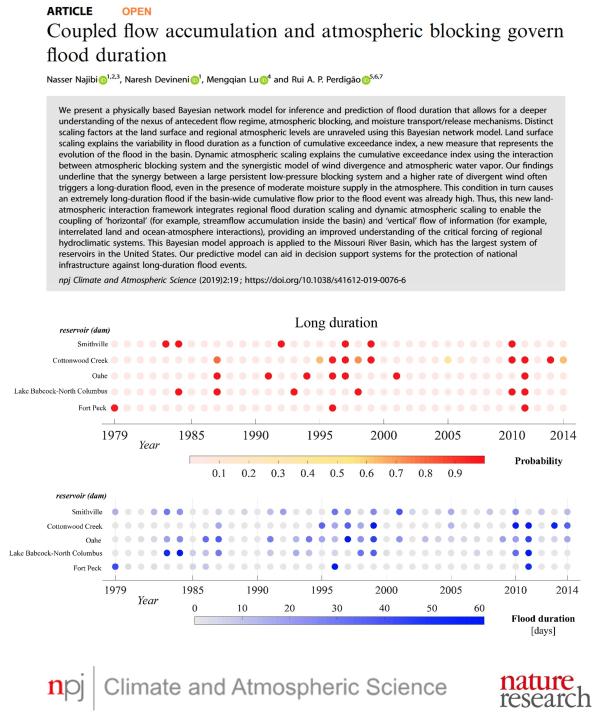
The duration of floods can be determined by river flow, precipitation and atmospheric blocking. Now an international team of researchers led by Nasser Najibi and Naresh Devineni at The City College of New York is offering a novel physically based Bayesian network model for inference and prediction of flood duration. The model also accurately examines the timescales of flooding.
Conceptualized by Najibi and tested on the Missouri River Basin, the statistical model is based on data in the area from the last 50 years. They found that long duration floods first require high flow conditions in rivers created by recurrent high intensity rainfall events, which is then followed by a large stable long-lived low-pressure system — a storm cell. These conditions may then result in large-scale devastating floods. In shorter duration floods, however, this land–atmospheric coupling is negligible thus explaining why not all storms result in widespread flooding.
“It is possible to predict the duration of floods by coupling atmospheric dynamics and land surface conditions in the watershed,” summed up Najibi, a PhD candidate majoring in civil and environmental engineering (water resources engineering) in CCNY’s Grove School of Engineering.
On the benefits of this new development, Najibi and Devineni said they are able to mitigate potential risk imposed by longer duration floods on critical infrastructure systems such as flood control dams, bridges and power plants. It is also possible to predict how long the duration of flooding and inundation will be.
Najibi and his team plan to expand their study, which appeared in the “Nature” research journal “npj Climate and Atmospheric Science,” across the United States. This work is part of Devineni’s DOE Early Career project funded by the U.S. Department of Energy.
Devineni is an associate professor in the Grove School and NOAA CREST. Other collaborators in the research include Mengqian Lu (Hong Kong University of Science and Technology) and Rui A. P. Perdigão (Universtät Wien, Austria/ University of Lisbon, Portugal).
About the Grove School of Engineering
CCNY’s Grove School of Engineering celebrates a century of educating engineers this year. Originally established as the School of Technology in 1919, it evolved to the School of Engineering in 1962 and was renamed The Grove School of Engineering in 2005 in honor of alumnus Andrew S. Grove, whose $26 million gift to the institution that year is the largest in CCNY’s history. A distinguished member of CCNY’s Class of 1960, Grove was a founder and former chairman of Intel Corp, one of the world’s leading producers of semiconductor chips. Today, the Grove School remains the only public school of engineering in the heart of New York City.
About The City College of New York
Since 1847, The City College of New York has provided a high quality and affordable education to generations of New Yorkers in a wide variety of disciplines. CCNY embraces its role at the forefront of social change. It is ranked #1 by the Harvard-based Opportunity Insights out of 369 selective public colleges in the United States on the overall mobility index. This measure reflects both access and outcomes, representing the likelihood that a student at CCNY can move up two or more income quintiles. In addition, the Center for World University Rankings places CCNY in the top 1.2% of universities worldwide in terms of academic excellence. More than 16,000 students pursue undergraduate and graduate degrees in eight professional schools and divisions, driven by significant funded research, creativity and scholarship. CCNY is as diverse, dynamic and visionary as New York City itself. View CCNY Media Kit.
Jay Mwamba
p: 212.650.7580
e:
jmwamba@ccny.cuny
.%65du" rel="nofollow">
jmwamba@ccny.cuny.edu
View CCNY Media Kit